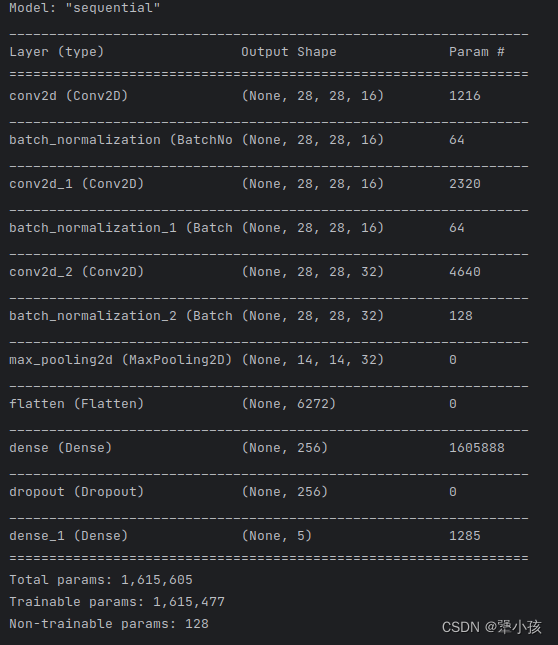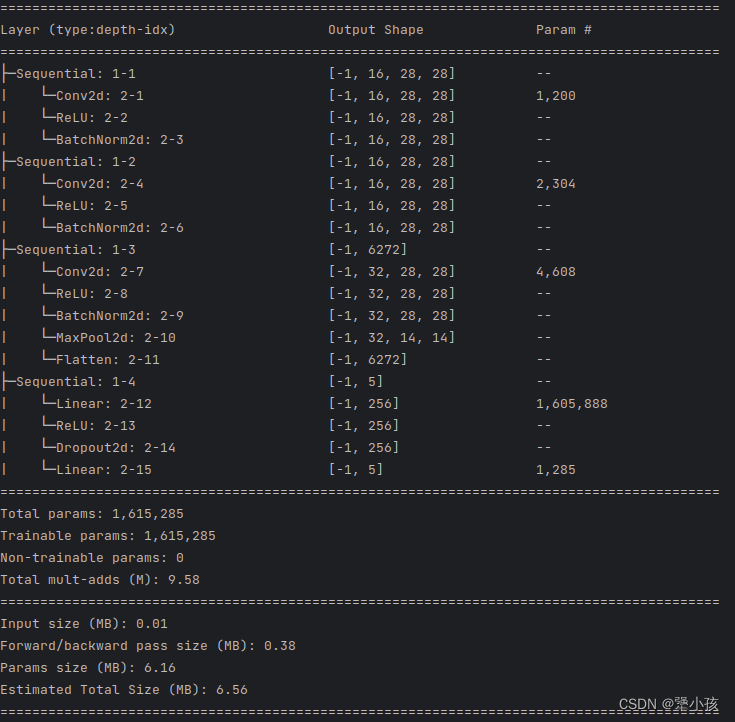前言
我在github搜了一个mnist分类代码,基于TensorFlow框架的,效果挺不错,但是我只想用pytorch,所以打算转成pytorch代码。
过程
TensorFlow网络:
def model_net(num):
model = Sequential()
model.add(Conv2D(filters=16, kernel_size=(5, 5), padding='Same',
activation='relu', input_shape=(28, 28, 3)))
model.add(BatchNormalization())
model.add(Conv2D(filters=16, kernel_size=(3, 3), padding='Same',
activation='relu'))
model.add(BatchNormalization())
model.add(Conv2D(filters=32, kernel_size=(3, 3), padding='Same',
activation='relu'))
model.add(BatchNormalization())
model.add(MaxPool2D(pool_size=(2, 2), strides=(2, 2)))
model.add(Flatten())
model.add(Dense(256, activation="relu"))
model.add(Dropout(0.5))
model.add(Dense(num, activation="softmax"))
return modelstep1:输出model的结构和参数
class_num=5
model = model_net(class_num)
model.summary()
from tensorflow.keras.utils import plot_model
plot_model(model, to_file='DResLayer_model.png', show_shapes=True)
print(model)结构如下:

step2:构造pytorch网络并输出结构:
模拟cnn构造一下:
class Mnist(nn.Module):
def __init__(self):
super(Mnist,self).__init__()
self.conv1 = nn.Sequential(
# 输入3,输出 16,核大小为5,步长1,填充边缘1,填充方式 0填充
nn.Conv2d(in_channels=3, out_channels=16, kernel_size=5,
stride=1, padding=2, bias=False),
nn.ReLU(),
# num_features取 通道数
nn.BatchNorm2d(num_features=16,affine=False)
)
self.conv2 = nn.Sequential(
nn.Conv2d(in_channels=16, out_channels=16, kernel_size=3,
stride=1, padding=1, bias=False),
nn.ReLU(),
nn.BatchNorm2d(num_features=16,affine=False)
)
self.conv3 = nn.Sequential(
nn.Conv2d(in_channels=16, out_channels=32, kernel_size=3,
stride=1, padding=1, bias=False)
, nn.ReLU(),
nn.BatchNorm2d(num_features=32,affine=False),
nn.MaxPool2d(kernel_size=2, stride=(2, 2)),
nn.Flatten()
)
self.fc = nn.Sequential(
nn.Linear(in_features=32 * 14 * 14, out_features=256),
nn.ReLU(),
nn.Dropout2d(0.5),
nn.Linear(in_features=256, out_features=5)
)
def forward(self, x):
x = self.conv1(x)
x = self.conv2(x)
x = self.conv3(x)
x = x.view(x.size(0), -1)
x = self.fc(x)
return x输出结构需要先 pip install torch-summary
model=Mnist()
print(model)
from torchsummary import summary
device = torch.device('cuda' if torch.cuda.is_available() else 'cpu')
t = model.to(device)
summary(t, (3, 28, 28))输出如下:

step3:对比结构和参数
参数略有不同,原因嘛。。。。。。,但是发现运行结果还是差不多的。